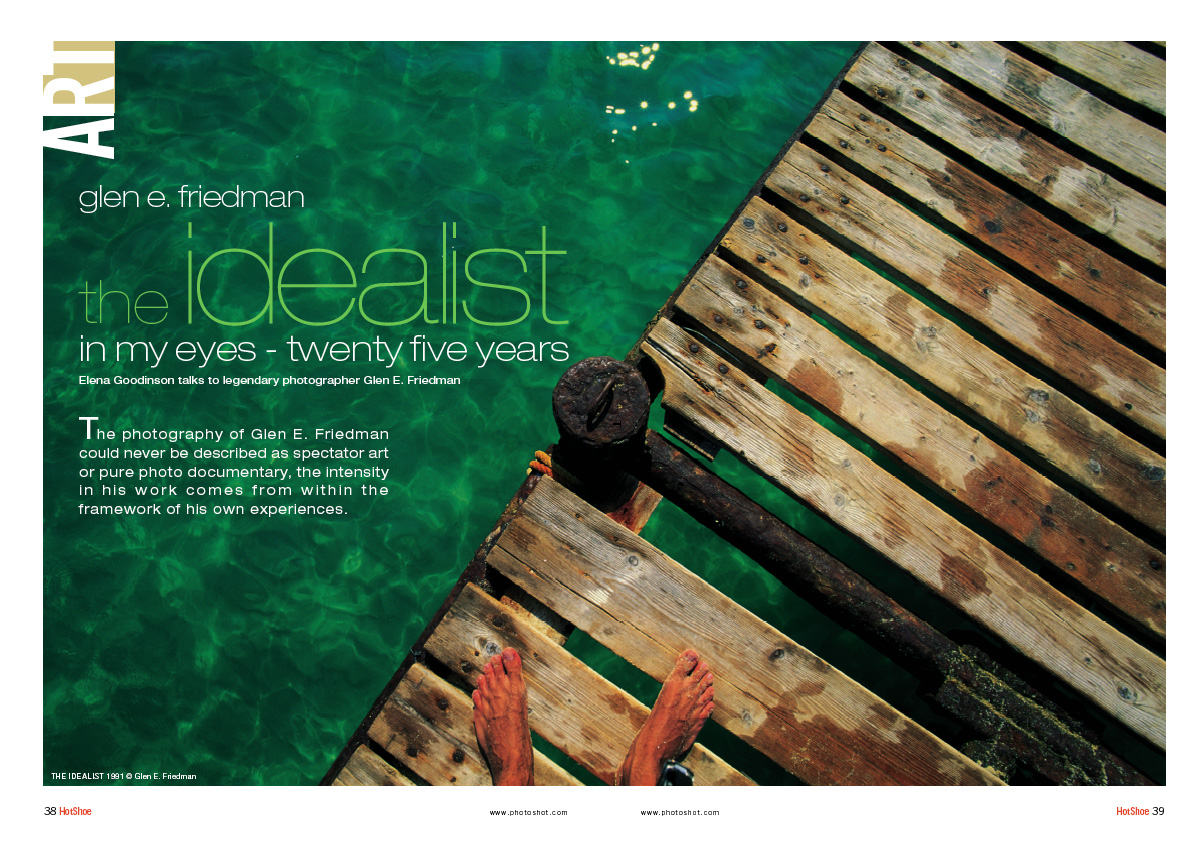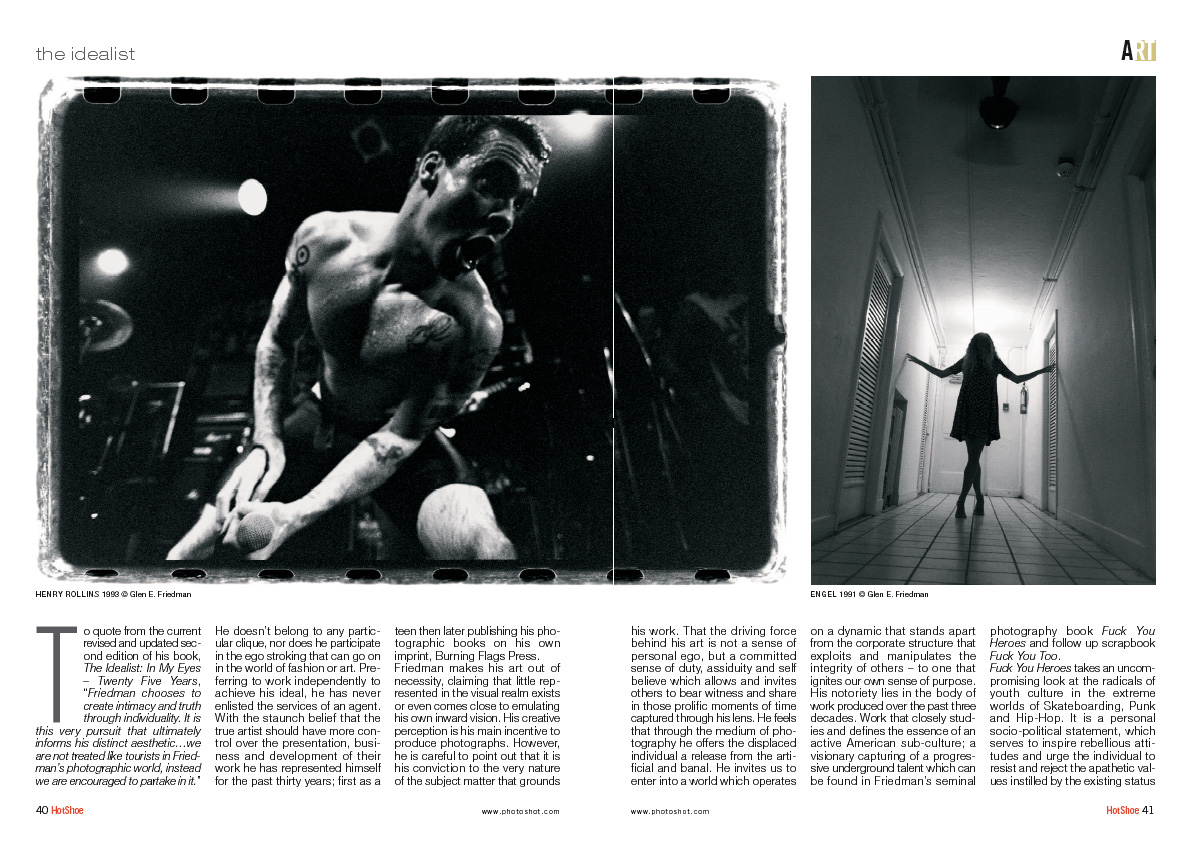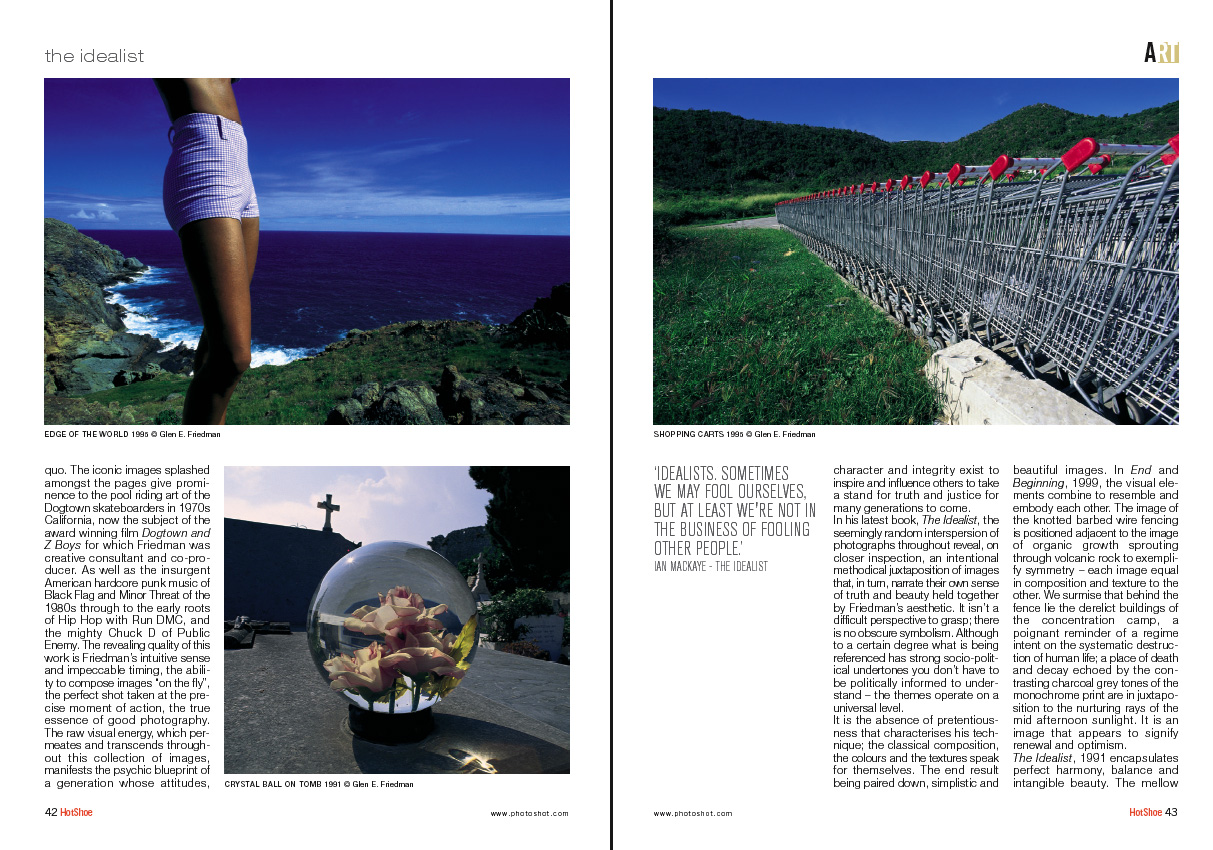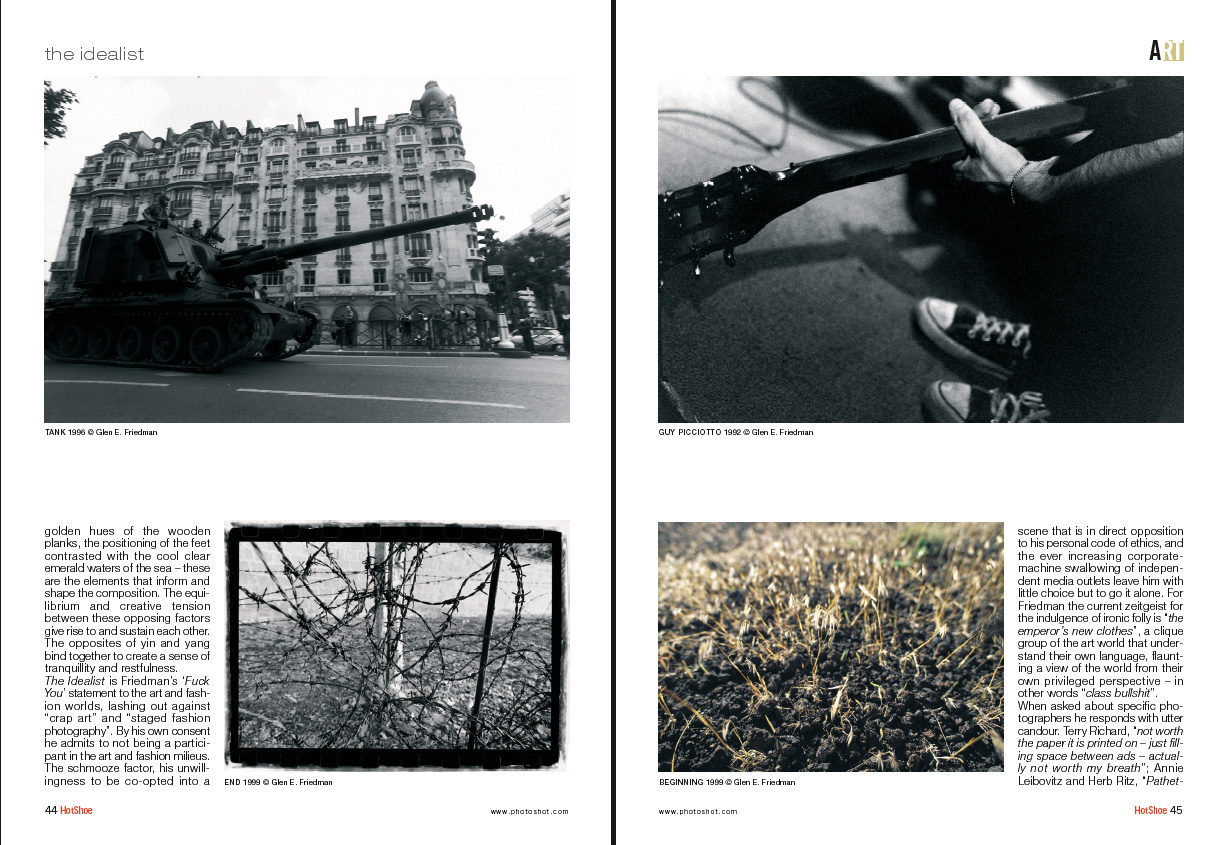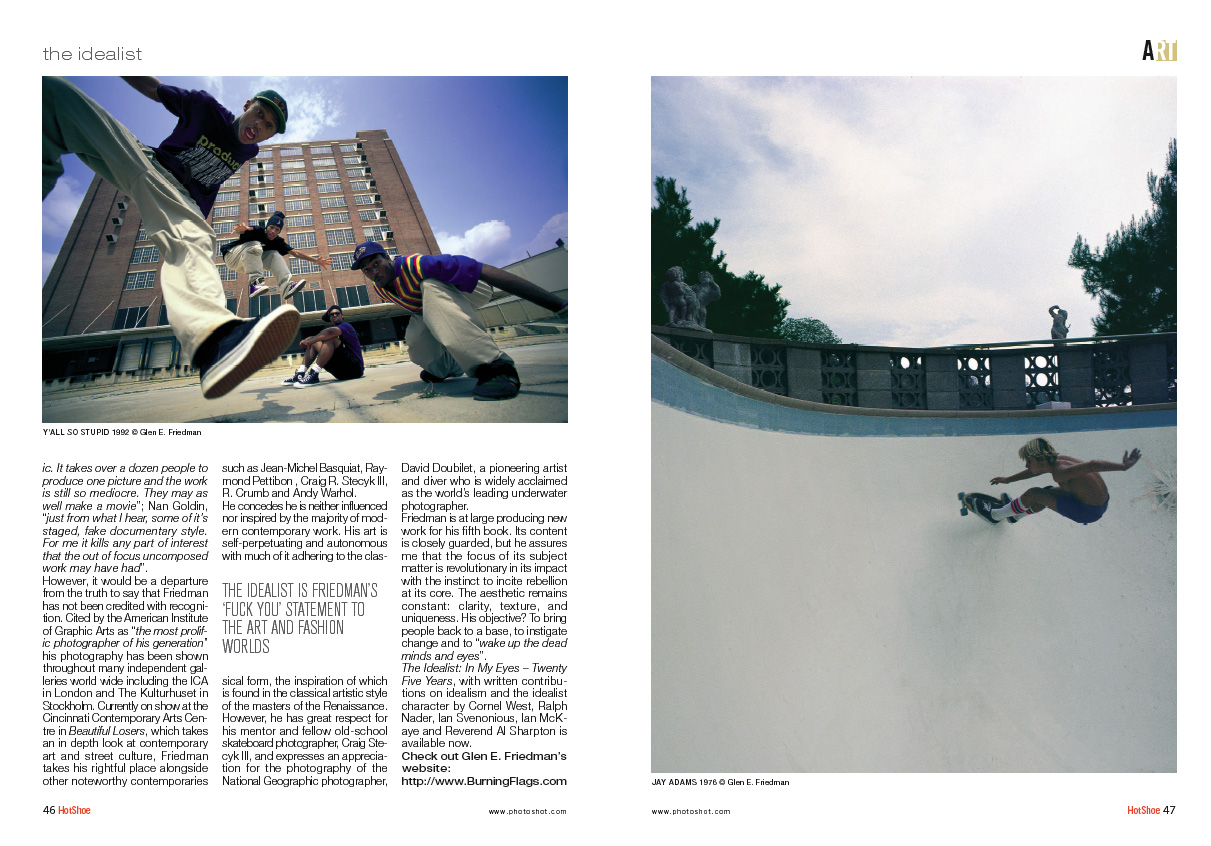April/May 2004 #129
HotShoe INTERNATIONAL (UK)
FRESH PERSPECTIVES ON CONTEMPORARY PHOTOGRAPHY
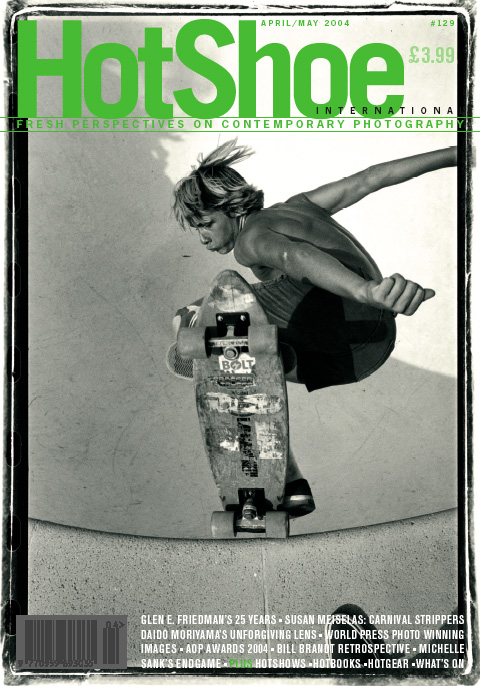

Elena Goodinson talks to legendary photographer Glen E. Friedman
The photography of Glen E. Friedman could never be described as spectator art or pure photo documentary, the intensity in his work comes from within the framework of his own experiences.
To quote from the current revised and updated second edition of his book, The Idealist: In My Eyes - Twenty Five Years, "Friedman chooses to create intimacy and truth through individuality. It is this very pursuit that ultimately informs his distinct aesthetic�we are not treated like tourists in Friedman's photographic world, instead we are encouraged to partake in it." He doesn't belong to any particular clique, nor does he participate in the ego stroking that can go on in the world of fashion or art. Preferring to work independently to achieve his ideal, he has never enlisted the services of an agent. With the staunch belief that the true artist should have more control over the presentation, business and development of their work he has represented himself for the past thirty years; first as a teen then later publishing his photographic books on his own imprint, Burning Flags Press.
Friedman makes his art out of necessity, claiming that little represented in the visual realm exists or even comes close to emulating his own inward vision. His creative perception is his main incentive to produce photographs. However, he is careful to point out that it is his conviction to the very nature of the subject matter that grounds his work. That the driving force behind his art is not a sense of personal ego, but a committed sense of duty, assiduity and self believe which allows and invites others to bear witness and share in those prolific moments of time captured through his lens. He feels that through the medium of photography he offers the displaced individual a release from the artificial and banal. He invites us to enter into a world which operates on a dynamic that stands apart from the corporate structure that exploits and manipulates the integrity of others - to one that ignites our own sense of purpose. His notoriety lies in the body of work produced over the past three decades. Work that closely studies and defines the essence of an active American sub-culture; a visionary capturing of a progressive underground talent which can be found in Friedman's seminal photography book Fuck You Heroes and follow up scrapbook Fuck You Too.
Fuck You Heroes takes an uncompromising look at the radicals of youth culture in the extreme worlds of Skateboarding, Punk and Hip-Hop. It is a personal socio-political statement, which serves to inspire rebellious attitudes and urge the individual to resist and reject the apathetic values instilled by the existing status quo. The iconic images splashed amongst the pages give prominence to the pool riding art of the Dogtown skateboarders in 1970s California, now the subject of the award winning film Dogtown and Z Boys for which Friedman was creative consultant and co-producer. As well as the insurgent American hardcore punk music of Black Flag and Minor Threat of the 1980s through to the early roots of Hip Hop with Run DMC, and the mighty Chuck D of Public Enemy. The revealing quality of this work is Friedman's intuitive sense and impeccable timing, the ability to compose images "on the fly", the perfect shot taken at the precise moment of action, the true essence of good photography. The raw visual energy, which permeates and transcends throughout this collection of images, manifests the psychic blueprint of a generation whose attitudes, character and integrity exist to inspire and influence others to take a stand for truth and justice for many generations to come.
In his latest book, The Idealist, the seemingly random interspersion of photographs throughout reveal, on closer inspection, an intentional methodical juxtaposition of images that, in turn, narrate their own sense of truth and beauty held together by Friedman's aesthetic. It isn't a difficult perspective to grasp; there is no obscure symbolism. Although to a certain degree what is being referenced has strong socio-political undertones you don't have to be politically informed to understand - the themes operate on a universal level.
It is the absence of pretentiousness that characterises his technique; the classical composition, the colours and the textures speak for themselves. The end result being paired down, simplistic and beautiful images. In End and Beginning, 1999, the visual elements combine to resemble and embody each other. The image of the knotted barbed wire fencing is positioned adjacent to the image of organic growth sprouting through volcanic rock to exemplify symmetry - each image equal in composition and texture to the other. We surmise that behind the fence lie the derelict buildings of the concentration camp, a poignant reminder of a regime intent on the systematic destruction of human life; a place of death and decay echoed by the contrasting charcoal grey tones of the monochrome print are in juxtaposition to the nurturing rays of the mid afternoon sunlight. It is an image that appears to signify renewal and optimism.
The Idealist, 1991 encapsulates perfect harmony, balance and intangible beauty. The mellow golden hues of the wooden planks, the positioning of the feet contrasted with the cool clear emerald waters of the sea - these are the elements that inform and shape the composition. The equilibrium and creative tension between these opposing factors give rise to and sustain each other. The opposites of yin and yang bind together to create a sense of tranquillity and restfulness.
The Idealist is Friedman's 'Fuck You' statement to the art and fashion worlds, lashing out against "crap art" and "staged fashion photography". By his own consent he admits to not being a participant in the art and fashion milieus. The schmooze factor, his unwillingness to be co-opted into a scene that is in direct opposition to his personal code of ethics, and the ever increasing corporatemachine swallowing of independent media outlets leave him with little choice but to go it alone. For Friedman the current zeitgeist for the indulgence of ironic folly is "the emperor's new clothes", a clique group of the art world that understand their own language, flaunting a view of the world from their own privileged perspective - in other words "class bullshit".
When asked about specific photographers he responds with utter candour. Terry Richardson, "not worth the paper it is printed on - just filling space between ads - actually not worth my breath"; Annie Leibovitz and Herb Ritz, "Pathetic. It takes over a dozen people to produce one picture and the work is still so mediocre. They may as well make a movie"; Nan Goldin, "just from what I hear, some of it's staged, fake documentary style. For me it kills any part of interest that the out of focus uncomposed work may have had".
However, it would be a departure from the truth to say that Friedman has not been credited with recognition. Cited by the American Institute of Graphic Arts as "the most prolific photographer of his generation" his photography has been shown throughout many independent galleries world wide including the ICA in London and The Kulturhuset in Stockholm. Currently on show at the Cincinnati Contemporary Arts Centre in Beautiful Losers, which takes an in depth look at contemporary art and street culture, Friedman takes his rightful place alongside other noteworthy contemporaries such as Jean-Michel Basquiat, Raymond Pettibon , Craig R. Stecyk III, R. Crumb and Andy Warhol.
He concedes he is neither influenced nor inspired by the majority of modern contemporary work. His art is self-perpetuating and autonomous with much of it adhering to the classical form, the inspiration of which is found in the classical artistic style of the masters of the Renaissance. However, he has great respect for his mentor and fellow old-school skateboard photographer, Craig Stecyk III, and expresses an appreciation for the photography of the National Geographic photographer, David Doubilet, a pioneering artist and diver who is widely acclaimed as the world's leading underwater photographer.
Friedman is at large producing new work for his fifth book. Its content is closely guarded, but he assures me that the focus of its subject matter is revolutionary in its impact with the instinct to incite rebellion at its core. The aesthetic remains constant: clarity, texture, and uniqueness. His objective? To bring people back to a base, to instigate change and to "wake up the dead minds and eyes".
The Idealist: In My Eyes - Twenty Five Years, with written contributions on idealism and the idealist character by Cornel West, Ralph Nader, Ian Svenonious, Ian McKaye and Reverend Al Sharpton is available now. Check out Glen E. Friedman''s website: http://www.BurningFlags.com
